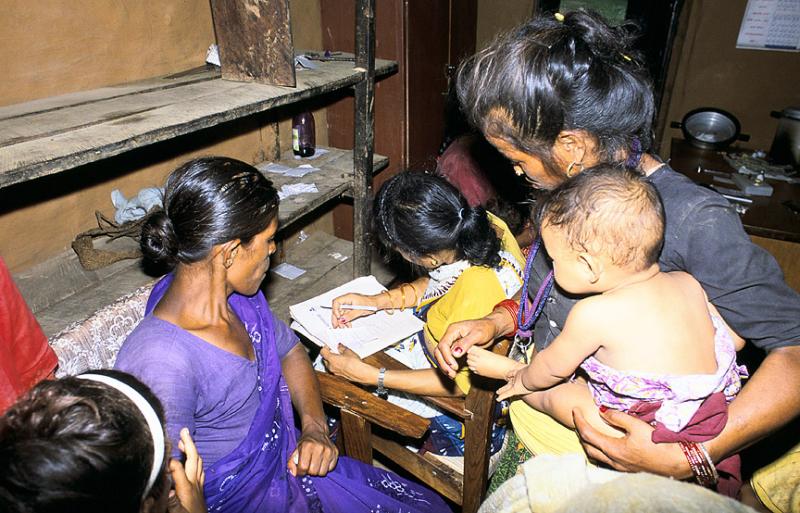| Psychological and psychosocial interventions reduce symptoms of depression by 52% in postpartum mothers.
Photo credit: Curt Carnemark Why are psychosocial or psychological interventions important? Postpartum depression is a major health issue for women of many cultures. Women suffering from postpartum depression experience disabling symptoms such as uneasiness, confusion, forgetfulness, irritability, fatigue, insomnia, anxiety, guilt, inability to cope, and thoughts of suicide. There may also be effects on the infant because of impaired maternal-infant interactions. Antidepressant medications are not widely used for postpartum depression because of concerns regarding whether they are transmitted to breast-fed infants. Therefore non-pharmaceutical treatments are important.
Do psychosocial or psychological interventions work? Psychosocial and psychological interventions reduce depressive symptoms by 52%. Psychosocial interventions, such as peer support and non-directive counseling were slightly more effective than psychological interventions (cognitive behavioural therapy and psychodynamic therapy).
Equity: do psychosocial or psychological interventions work in the disadvantaged? None of the included studies were conducted in low or middle income countries and does not provide a description of the participants according to the PROGRESS-Plus criteria (see notes in the right-hand column). However, the results are likely applicable for disadvantaged mothers.
Intervention Delivery
Population and Setting
|
Summary of Findings [SOF] Tables:
Patient or population: Mothers with postpartum depression in high-income countries
Settings: High income countries – Australia, Canada, Sweden, United Kingdom, United States
Intervention: All interventions, psychosocial only, psychological only
Comparison: Usual postpartum care
| Outcomes |
| Anticipated absolute effects per year | Odds Ratio | No of Participants | Quality of the evidence | |
|
|
| Risk without psychosocial or psychological interventions (Control) | Risk difference with psychosocial or psychological interventions (95% CI) |
|
|
|
| All Intervention: Evidence of depression at final assessment within 1 year |
|
|
|
|
|
|
| - any measure of depressive symptomatology |
| 52.8 per 100 | 15.8 fewer per 100 (from 10.0 to 21.1 fewer) | OR 0.48 (0.37-0.62) | 956 (9) | Moderate |
| - Edinburgh Postnatal Depression Scale (EPDS) >12 |
| 56.1 per 100 | 31.4 fewer per 100 (from 11.2 to 42.6 fewer) | OR 0.26 (0.10-0.67) | 81 (1) | Low |
| - Individually based interventions |
| 52.2 per 100 | 15.1 fewer per 100 (from 9.4 to 20.4 fewer) | OR 0.49 (0.37-0.68) | 917 (8) | Moderate |
| - Group-based interventions |
| 63.2 per 100 | 28.39 fewer per 100 (from 45.5 fewer to 6.3 more) | OR 0.31 (0.08-1.16) | 39 (1) | Low
|
| Psychosocial interventions – evidence of depression at final assessment within first year |
| 45.8 per 100 | 17.86 fewer per 100 (from 2.8 to 27.9 fewer) | OR 0.54 (0.37-0.77) | 506 (5) | Moderate |
| Psychological interventions – evidence of depression at final assessment within first year: Cognitive-behavioural therapy |
| 43.95 per 100 | 12.31 fewer per 100 (from 4.4 to 18.9 fewer) | OR 0.61 (0.42-0.89) | 482 (5) | Moderate |
| Psychological interventions – evidence of depression at final assessment within first year – Cognitive behavioural therapy and interpersonal psychotherapy |
| 52.0 per 100 | 13.0 fewer per 100 (from 6.2 to 19.2 fewer) | OR 0.61 (0.44-0.84) | 602 (6) | Moderate |
| Adverse Events: | ||||||
| About quality of evidence (GRADE) | ||||||
1. The authors assessed the papers as low methodological quality.
2. Only one study with low sample size.
Relevance of the review for disadvantaged communities | |
| Findings | Interpretation |
| Equity - Which of the PROGRESS groups examined | |
| The studies included postpartum women who had been diagnosed or self-reported as depressed. | This review aimed to assess the effectiveness of interventions to treat postpartum depression but does not provide evidence for preventing postpartum depression. Another Cochrane systematic review addresses prevention. |
| Equity Applicability | |
| All included studies were conducted in high-income countries. | The interventions may have different effectiveness within different settings depending on the social, cultural, and organizational environments. Psychosocial and psychological interventions are likely to be effective in disadvantage populations. |
| There are many barriers to postpartum depression treatment including stigma, transportation, and childcare. | Policymakers implementing interventions to treat postpartum depression need to ensure these barriers are addressed to ensure treatments are accessible. Alternative treatments, such as telephone based counseling or support, are options to overcome these barriers. |
| Cost-equity | |
| None of the included studies examined the costs of psychological and psychosocial interventions. | The interventions are labour intensive and therefore could have high costs. The costs of treatment need to be determined and weighed against the benefits of the treatment. For individual patients, certain interventions, for example, telephone peer support could be more cost-equitable than medications or counseling. |

